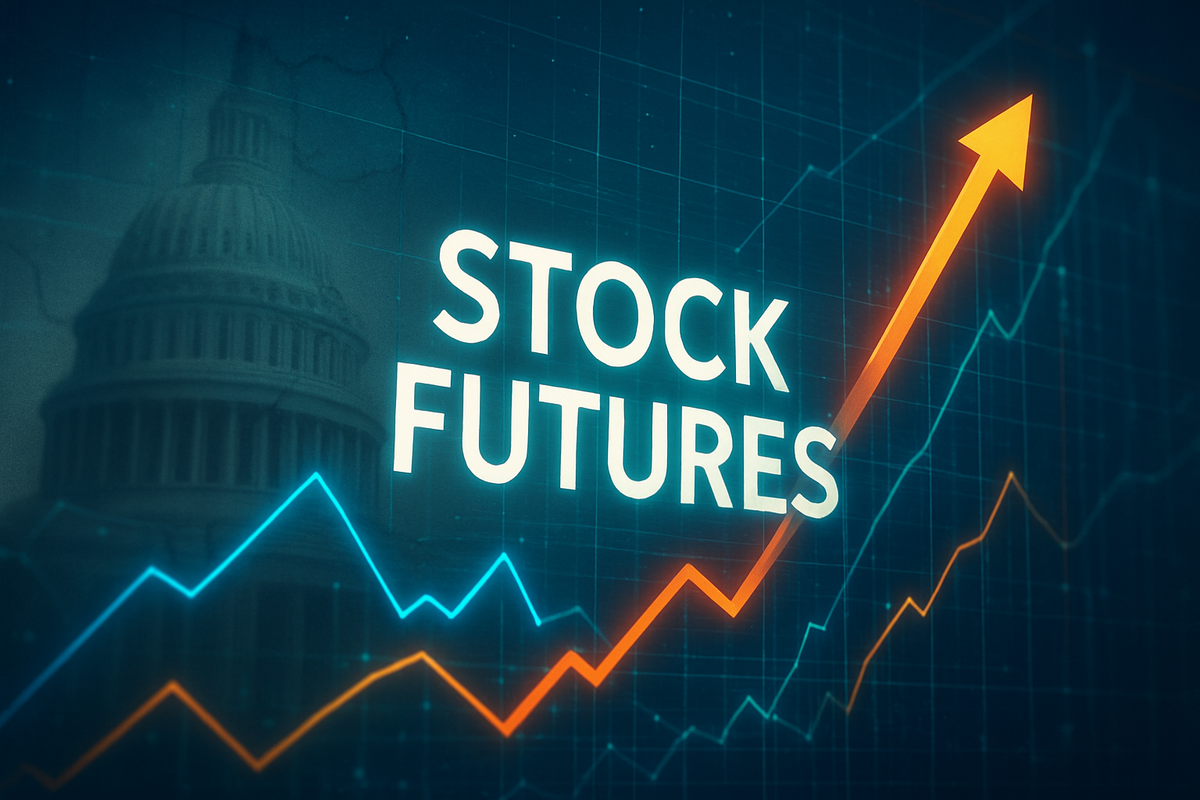
In the dynamic world of financial markets, stock futures stand as an indispensable, 24-hour sentinel, offering critical insights into investor sentiment and future market expectations long before the opening bell rings. These sophisticated financial instruments, which allow traders to lock in a price today for an asset to be bought or sold at a predetermined future date, act as a real-time pulse of global financial health. Their continuous trading nature makes them particularly adept at capturing and reacting to overnight news, international market shifts, and investor responses to events unfolding outside standard trading hours. As such, they provide a crucial early signal for how the broader market is likely to behave, making them a key barometer for market participants.
The recent period, particularly encompassing events in late 2024 and 2025, has vividly underscored the pivotal role of stock futures. From navigating the uncertainties of a prolonged US government shutdown to signaling both caution and exuberance during significant market rallies and corrections, futures contracts have consistently provided a forward-looking lens into the collective psyche of investors. Their movements offer a crucial indicator of optimism or pessimism, instantly adjusting to anticipated economic reports, corporate earnings, and geopolitical developments, thereby guiding trading strategies and informing market expectations.
Navigating Gridlock and Growth: A Look at Recent Market Reactions
The latter half of 2025 presented a stark illustration of stock futures' predictive power, particularly during the protracted US government shutdown. Beginning on October 1, 2025, and extending for an unprecedented 40 days, this fiscal stalemate injected significant uncertainty into the economy and financial markets. As the shutdown dragged on, the lack of new economic data and growing concerns over its economic impact contributed to underlying apprehension, despite some resilience in specific market segments.
However, a pivotal moment arrived on Saturday, November 9, 2025, when reports emerged of substantial progress towards a bipartisan deal in the U.S. Senate to end the shutdown. This news immediately sparked a surge of optimism across global financial markets. Stock futures, trading in early Asian hours on Sunday, November 10, 2025, surged in anticipation of a resolution. Contracts tied to the S&P 500 (SPX) and Nasdaq 100 (NDX) indices both climbed by over 0.5%, reflecting investors' eagerness for stability and predictability. This immediate positive reaction, even before the official market open, underscored the market's deep desire for an end to the political gridlock. As Sunday evening progressed, further reports of an impending deal saw Wall Street futures, including those for the Dow Jones Industrial Average (DJIA), S&P 500 (SPX), and Nasdaq 100 (NDX), post additional gains, signaling a strong start to the trading week.
Beyond political impasses, stock futures have also been instrumental in reflecting broader market trends. The period of 2024-2025 witnessed significant market rallies, with the S&P 500 (SPX) and Nasdaq Composite (IXIC) reaching new record highs. For instance, by July 2025, the S&P 500 (SPX) had surged nearly 30% from its April 52-week low, while the Nasdaq Composite (IXIC) was up almost 40%. These rallies were largely fueled by hopes of better-than-expected inflation data, which would provide the Federal Reserve (FED) with greater flexibility to implement interest rate cuts, thereby boosting investment prices and stimulating economic growth. Yet, even amidst such strong bullish trends, stock futures offered nuanced signals. Following a robust rally into July 2025, futures trading on a Sunday evening suggested a potential lower open for stocks, despite the major indices having closed at record highs just days prior. This demonstrated how futures provide real-time adjustments to sentiment, reflecting immediate investor reactions and potential shifts even within a generally positive market environment.
Conversely, stock futures also sharply reacted to negative developments. The global stock market experienced a notable downturn starting April 2, 2025, following new tariff policies introduced by then-President Donald Trump. S&P 500 (SPX), Nasdaq-100 (NDX), and Dow Jones Industrial Average (DJIA) futures tumbled significantly on that day. However, the market saw a subsequent powerful rally, with major U.S. indices posting their largest gains in years after the Trump administration announced a pause on tariff increases on April 9, 2025. By June 27, 2025, both the S&P 500 (SPX) and Nasdaq (IXIC) had closed at all-time highs, showcasing the rapid rebound and recovery signaled by futures as the economic outlook improved.
Corporate Fortunes Tied to Policy and Perception
The impact of events like a US government shutdown or broad market rallies, as reflected in stock futures, reverberates across various public companies and sectors. During the October-November 2025 government shutdown, companies heavily reliant on government contracts or regulatory approvals faced significant headwinds. Defense contractors like Lockheed Martin (NYSE: LMT) and Boeing (NYSE: BA), alongside IT service providers to federal agencies such as Leidos Holdings (NYSE: LDOS) and Booz Allen Hamilton (NYSE: BAH), likely experienced delays in contract awards, payments, and project initiations. This uncertainty could have led to a slowdown in their revenue recognition and dampened investor confidence, potentially causing their stock prices to underperform the broader market, even if futures indicated a potential resolution.
Furthermore, sectors requiring extensive government oversight, such as pharmaceuticals, biotechnology, and certain financial services, might have seen operational delays due to furloughed regulatory staff. Companies awaiting drug approvals from the Food and Drug Administration (FDA) or permits from environmental agencies could have faced significant bottlenecks, impacting their development timelines and market entry strategies. Small businesses, often more vulnerable to cash flow disruptions, could have faced severe liquidity challenges if government-backed loans or services were suspended.
Conversely, the market rallies of 2024-2025, often driven by optimism around interest rate cuts and strong economic data, generally benefited growth-oriented companies and technology giants. Companies like Apple (NASDAQ: AAPL), Microsoft (NASDAQ: MSFT), Amazon (NASDAQ: AMZN), and Alphabet (NASDAQ: GOOGL) (NASDAQ: GOOG) frequently lead such rallies, driven by investor confidence in their innovation, market dominance, and potential for future earnings growth. Lower interest rates typically reduce borrowing costs and increase the present value of future earnings, making these high-growth stocks more attractive. Financial institutions, such as JPMorgan Chase (NYSE: JPM) and Bank of America (NYSE: BAC), might also see a mixed impact; while lower rates could compress net interest margins, a robust economy and increased market activity generally boost their other business segments like investment banking and asset management.
However, even during rallies, futures can signal underlying caution. For instance, if futures suggested a lower open after a strong run, it could indicate profit-taking in overextended tech stocks or a shift towards more value-oriented sectors. Companies in defensive sectors, such as utilities like NextEra Energy (NYSE: NEE) or consumer staples like Procter & Gamble (NYSE: PG), might experience less volatility during broad market swings but could see reduced investor interest during strong growth-driven rallies. The swift reaction of futures to events like the April 2025 tariff announcements also highlights the vulnerability of companies with significant international supply chains or export exposure, such as multinational manufacturers and agricultural firms, to sudden policy shifts.
Wider Implications: A Tapestry of Trends and Precedents
The recent interplay between stock futures, political events like the US shutdown, and broader market movements like rallies and corrections, fits squarely within a larger narrative of market sensitivity to both policy certainty and economic fundamentals. This period underscores a persistent trend: financial markets abhor uncertainty. A government shutdown, regardless of its duration, introduces an unpredictable element that affects economic data, regulatory processes, and investor confidence. The immediate surge in stock futures upon news of a potential resolution in November 2025 highlights the market's deep-seated desire for stability and predictability, viewing political gridlock as a significant drag on economic activity.
From a broader industry perspective, prolonged government disruptions can have ripple effects far beyond direct government contractors. Supply chains can be disrupted, consumer confidence can wane, and investment decisions can be postponed across various sectors. Competitors, especially international ones, might gain an edge if domestic operations are hampered. For instance, if US-based biotech firms face FDA approval delays due to a shutdown, their European or Asian counterparts might accelerate their market penetration. Partners in joint ventures or suppliers to affected companies could also face unforeseen challenges, leading to contract renegotiations or even cancellations.
Regulatory and policy implications are profound. The 2025 shutdown could reignite debates about fiscal responsibility, the debt ceiling, and the legislative process itself. Future policy frameworks might be designed to mitigate the economic fallout of potential future shutdowns, perhaps by ensuring essential economic functions or payments are insulated from political stalemates. Historically, government shutdowns have often led to temporary market dips followed by recoveries once a resolution is reached, as seen in previous instances. However, the 2025 shutdown, being particularly long, likely amplified concerns about long-term fiscal stability and governance effectiveness.
Comparing the market's reaction to the 2025 shutdown with the 2024-2025 market rallies reveals a clear dichotomy. Rallies, often fueled by expectations of favorable monetary policy (e.g., interest rate cuts) and robust corporate earnings, demonstrate the market's responsiveness to positive economic catalysts. The sharp rebound after the April 2025 tariff pause further illustrates how quickly markets can pivot when a perceived threat is alleviated. These events collectively underscore that while fundamental economic health drives long-term trends, short-term market movements, heavily influenced by sentiment reflected in futures, are highly susceptible to policy announcements, geopolitical shifts, and the ebb and flow of investor confidence.
The Path Ahead: Navigating a Complex Landscape
Looking ahead, the role of stock futures as a forward-looking indicator will remain paramount as markets navigate a complex interplay of economic, political, and technological forces. In the short term, the aftermath of the 2025 US government shutdown will likely involve a period of economic data catch-up and a reassessment of corporate earnings projections for companies impacted by the disruption. Investors will closely watch futures for signs of sustained market confidence or renewed apprehension as the economy fully reopens and data flow normalizes. Any lingering political tensions or signs of future legislative stalemates could quickly dampen sentiment reflected in futures.
In the long term, potential strategic pivots for businesses might include diversifying supply chains to reduce reliance on single-country political stability or increasing lobbying efforts to advocate for more predictable policy environments. For government contractors, this might involve exploring private sector opportunities or diversifying their client base. Market opportunities could emerge in sectors that demonstrate resilience to political uncertainty or those poised to benefit from renewed government spending post-shutdown. For instance, infrastructure companies could see increased activity if a bipartisan infrastructure bill gains traction. Conversely, challenges might arise for sectors still grappling with regulatory backlogs or those heavily exposed to discretionary government spending.
Potential scenarios and outcomes are varied. A smooth legislative path forward, coupled with strong economic data, could lead to sustained market rallies, with futures consistently signaling bullish sentiment. However, renewed geopolitical tensions, unexpected inflation spikes, or further political gridlock could trigger corrections, with futures acting as the first alarm. Investors should anticipate increased volatility around major economic data releases and policy announcements, using futures as a real-time gauge of market interpretation. The ongoing evolution of monetary policy, particularly the Federal Reserve's stance on interest rates, will continue to be a dominant theme, with futures movements closely tracking expectations for rate cuts or hikes.
Conclusion: Futures as the Guiding Light
The events of late 2024 and 2025 unequivocally reinforce the critical role of stock futures as a guiding light in the often-turbulent financial markets. Their ability to trade virtually 24 hours a day allows them to serve as an unparalleled barometer of market sentiment and future expectations, instantly reacting to a continuous stream of information—from the resolution of a prolonged US government shutdown to the optimistic signals of broad market rallies and the sharp corrections triggered by policy shifts. The immediate surge in futures upon news of a potential end to the 2025 shutdown, or their quick rebound after a tariff threat was paused, vividly demonstrates their capacity to reflect collective investor confidence and apprehension in real-time.
Moving forward, investors must recognize that stock futures are not merely speculative instruments but powerful indicators that encapsulate the market's forward-looking assessment of economic health, corporate prospects, and geopolitical stability. Their movements provide crucial signals about potential market direction before regular trading hours commence, offering an invaluable tool for risk management and strategic positioning. The lasting impact of events like the 2025 shutdown will likely shape future policy considerations regarding fiscal stability and legislative predictability, further emphasizing the interconnectedness of politics and financial markets.
As the market continues to evolve, investors should remain vigilant, closely monitoring stock futures for early indications of shifts in sentiment, particularly around major economic announcements, corporate earnings reports, and political developments. Understanding the language of futures—their pre-market movements, their reactions to global news, and their reflection of investor optimism or pessimism—will be paramount for navigating the complexities of the financial landscape in the coming months and making informed investment decisions.
This content is intended for informational purposes only and is not financial advice






